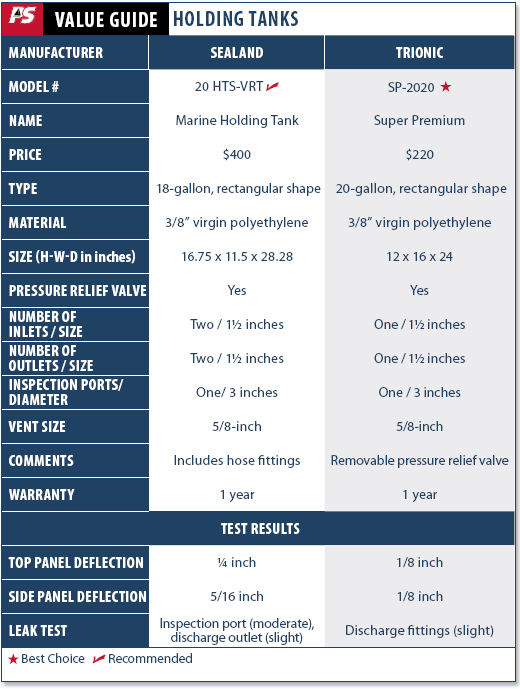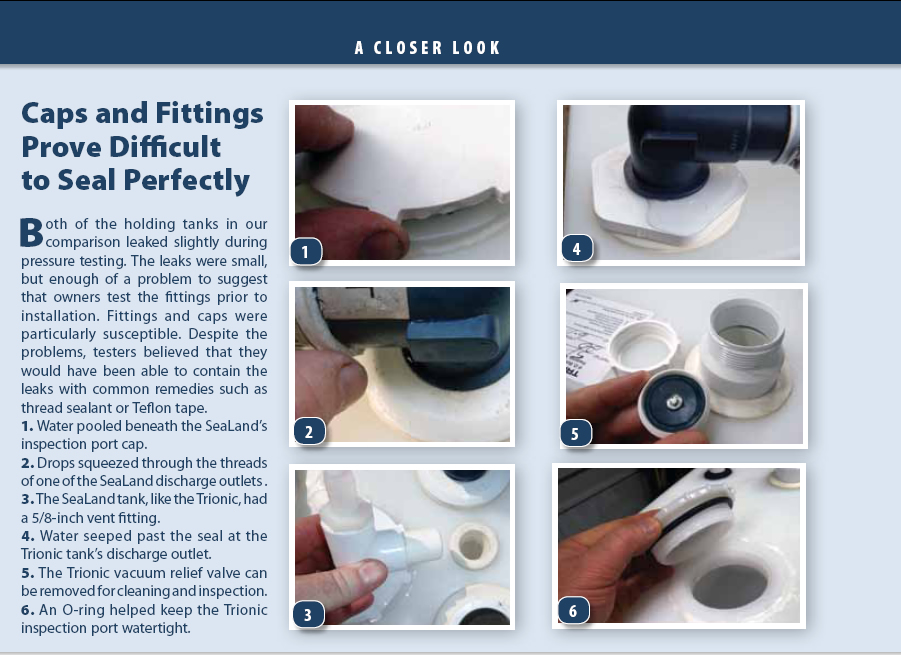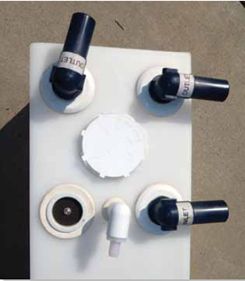
Photos by Frank Lanier
234
Editor’s note: The SeaLand tank referred to in this test is a pre-2009 model, not the most current version at the time of the test. The newer tanks have a different gasket at the cleanout/inspection cap to prevent leaks. See the Holding Tank Test Correction for more details.
During our September 2002 look at holding tanks, we fantasized about the invention of some scientific doodad that could make waste disappear with the push of a button or at least transmogrify it into something useful (such as biodiesel or gold doubloons). Until that happy day arrives, sailors will continue to have need of a reliable way to collect and store waste until it can be properly disposed of. The undisputed heart of any such system continues to be the holding tank.

245
In our 2002 test of four popular holding tanks, the unit from SeaLand floated to the top of the group to earn a Best Choice rating. As more than nine years have elapsed since then, we decided to revisit holding tanks, both to smell out any new advances in design and construction, and to see how our top choice of 2002 would compare with a new kid on the block.
Getting Tanked
The tank material of choice continues to be rotationally molded linear polyethylene. Polyethylene is light in weight, doesn’t corrode, allows for seamless tank construction, is relatively inexpensive and (if thick enough) won’t allow odors to permeate. In short, a good quality polyethylene tank could very well outlast the hull of the boat you’re installing it in.
On the construction front, one improvement we did note was placement of the tank fittings, particularly the discharge outlet. All of the holding tanks in our 2002 test had discharge outlets located at the sides near the bottom, in efforts to allow users to drain as much waste as possible when pumping out.
Today, the trend (with better quality tanks anyway) is to use all top- mounted fittings. This placement not only reduces the potential for leaks, but also prevents sewage from sitting in the discharge hose, reducing the chance of hose failure and odor problems due to permeation.
Top-mounted outlet fittings use a ridged PVC pump-out tube (SeaLand labels theirs a “diptube”) that extends to a point just above the bottom of the tank. This design reduces the chance of plugging, while allowing most all of the waste to be pumped out.
What We Tested
This test pitted a holding tank from SeaLand with a comparable tank from Trionic Corp.
Since the SeaLand tank we tested in 2002 was no longer available, we chose a current model that was similar in size and construction, the 18-gallon 20 HTS-VRT from SeaLand’s Basic Series lineup.
Trionic provided us a 20-gallon SP-2020 model from its line of super premium holding tanks.
While the tanks in our test were rectangular, both Trionic and SeaLand offer a variety of other shapes.
How We Tested
Tanks were tested per Code of Federal Regulations 159.109, which states, “Any sewage retention tank that is designed to operate under pressure must be pressurized hydrostatically at a pressure head of 7 feet or to 150 percent of the maximum pressure specified by the manufacturer for operation of the tank, whichever is greater. The tank must hold the water at this pressure for one hour with no evidence of leaking.”
To accomplish this, we attached a section of hose to each tank and hydrostatically pressurized them to a head of 7 feet. Once pressurized, each tank was monitored for leaks and deflection. Tanks also were rated on factors such as cost, quality of construction, and features (inspection ports, pressure relief valves, options for additional fittings, etc.).
Preventing threaded fittings from leaking was the hardest part of this test. Teflon tape was used with some success, though nylon fittings in polyethylene tank walls generally make for a tight fit. Still, you’d be surprised how much pressure is created with 7 feet of head.
Once the leaks were minimized and the water level stabilized to the extent possible, we waited the required one hour, and then measured the amount of deflection.
SeaLand 20 HTS
The 20 HTS is constructed of 3/8-inch virgin, low linear density polyethylene and is ISO/USCG compliant. The 20 HTS comes with a ⅝-inch vent, 3-inch inspection port, 1½-inch inlet, and two 1½-inch discharge outlets (one for connection to a deck mounted discharge fitting, the other for connection to an overboard discharge pump). Testers particularly liked inclusion of the second discharge outlet as standard equipment (and the greater installation versatility it provides). Hose fittings for the inlet and both outlets were also included.
The 20 HTS comes equipped with a TankSaver vacuum relief valve, which protects the tank from implosion damage due to excessive dockside pumpout vacuum levels. The capacity of the 20 HTS was advertised as 18 gallons, however its measurements were strangely a bit larger than those of the 20-gallon Trionic tank.
After one hour under pressure, the 20 HTS was measured for panel deflection. Side panel deflection was 5/16-inch per side, while both the top and bottom panel had ¼-inch of deflection. As with noted in our 2002 test, despite a good deal of fiddling with the fittings and application of Teflon tape, we had leaks at both the 3-inch access plate and at one of the discharge outlet fittings that we were unable to stop completely with a 7-foot head. The fitting leak was fairly minor; the access plate leak was a bit more pronounced.
Bottom line: The 20 HT is a good quality tank that comes standard with features we liked, but costs roughly $60 more than the Trionic (even after factoring in the additional cost for a second discharge outlet for the Trionic tank). It gets a Recommended rating from our testers.
Trionic SP-2020
Trionic’s Super Premium Holding Tanks are constructed of 3/8-inch-thick virgin polyethylene and comply with U. S. Coast Guard requirements. The SP-2020 comes with a 5/8-inch barb vent assembly, 3-inch inspection port, 1½-inch inlet, and a 1½-inch discharge outlet and all fittings, as well as a 1½-inch screw in plug. A second overboard discharge is available as an option, but costs an additional $30. As with the SeaLand 20 HTS, all fittings were mounted at the top of the tank.
The SP-2020 also features a vacuum relief valve to prevent tank collapse due to dock pump out stations with high vacuum levels. Testers particularly liked the screw-cap design of the Trionic relief valve, which provided easy access for cleaning.
After one hour at pressure, total panel deflection for the top, bottom,and side panels was a miserly 1/8-inch each. As with the SeaLand tank, we were unable to completely eliminate leaking with a 7-foot head. The SP-2020 leaked only at the discharge fitting and that leak was very minor. There were no leaks at the inspection port.
Bottom line: The SP-2020 not only cost less than the SeaLand 20 HTS, but also had less material deflection and leakage. It received a Best Choice rating from our testers.
Conclusion
Both holding tanks were of high quality and would carry out their duties of holding doody well. Although both had minor leaks during our test, we think we could have eventually finessed them to hold 7 feet of head.
That being said, the leaks that did exist were more pronounced with the SeaLand tank, specifically the one at the inspection port—this was possibly due to a combination of its larger diameter (as compared to the leaky outlet fitting) and the greater deflection of the top panel where it was located. [Editor’s note: Please read Dometic’s response to this article here. Practical Sailor will be re-testing both tanks using off-the-shelf sealants recommended by professional installers. For more details see the a full-report is forthcoming in the April issue.]
Although not conclusive in and of itself, less deflection would seem to indicate greater strength, and while the difference wasn’t huge, deflection for the Trionic tank was noticeably less than the SeaLand unit.
Taking the test results and the price difference into consideration, the Trionic SP-2020 adds up to a better value in this holding tank size range.









































